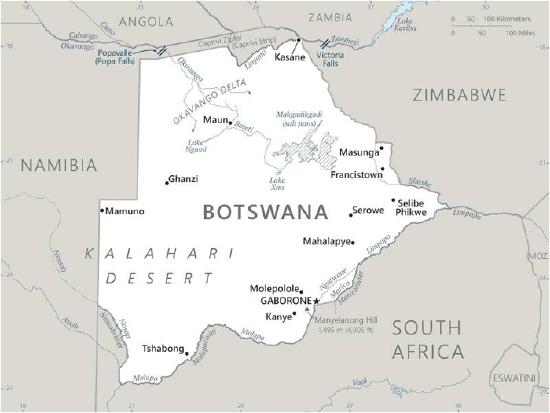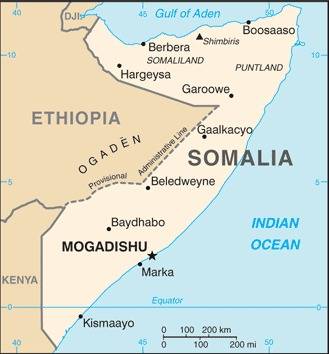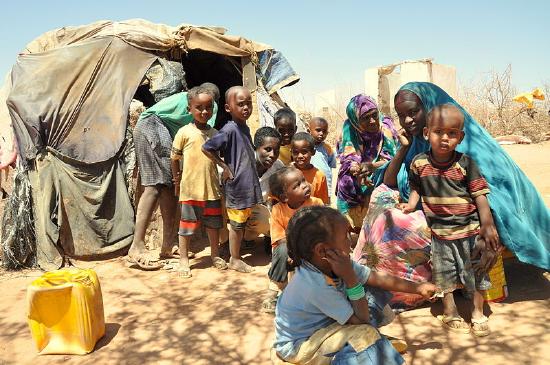3.3: Comparative Case Study - Botswana and Somalia
- Last updated
- Save as PDF
- Page ID
- 135836

- Dino Bozonelos, Julia Wendt, Charlotte Lee, Jessica Scarffe, Masahiro Omae, Josh Franco, Byran Martin, & Stefan Veldhuis
- Victor Valley College, Berkeley City College, Allan Hancock College, San Diego City College, Cuyamaca College, Houston Community College, and Long Beach City College via ASCCC Open Educational Resources Initiative (OERI)
Learning Objectives
By the end of this section, you will be able to:
- Compare and contrast Botswana and Somalia’s historical context for political outcomes
- Apply understanding of political capacity in Botswana and Somalia
Introduction
Why compare and contrast Botswana and Somalia? Why select these two countries for consideration when discussing the main focal point of “the state?” The selection of Botswana and Somalia is interesting to consider when evaluating the relevance of the state, and in terms of methods for selecting case studies, this selection could be categorized as falling into Most Similar Systems Design. The Most Similar Systems Design (MSSD) asks comparativists to consider at least two cases where the cases are similar, but the outcomes from these cases are different. Botswana and Somalia have a number of geographic and historical circumstances in common, and yet the resulting political outcomes have been very different. The primary difference between these two countries are their forms of legitimate authority.
Botswana

- Full Country Name: Botswana, Republic of Botswana
- Head(s) of State: President
- Government: Parliamentary Republic
- Official Languages: Setswana, English
- Economic System: Market-Oriented Economy
- Location: Southern Africa
- Capital: Gaborone
- Total land size: 224,610 sq. miles
- Population: 2,254,069
- GDP: $18.726 billion
- GDP per capita: $7,817
- Currency: Pula
The Republic of Botswana is located in southern Africa, and is a landlocked country. Botswana is bordered by South Africa to the south, Namibia to the northwest, and Zimbabwe to the northeast. Botswana has a long history, and is credited with perhaps being the “birthplace” of all modern humans dating back over 200,000 years ago. Much of what is known about the ancient Botswana region is derived from archeological and anthropological research, which has traced evidence of human civilization through ancient tools, cave drawings and evidence of farming practices that existed through the region over time. Although there is robust evidence of the region’s population adopting agricultural practices and having tribal norms and values that were followed, the first actual written records of life in Botswana were not noted until around the 1820s.
Botswana was one of many African countries affected by the Scramble for Africa, sometimes also called the conquest of Africa, wherein Western European powers attempted to control and colonize all parts of Africa. The Scramble for Africa occurred between the years of 1880 to 1914, with countries like Britain, France, Belgium, Portugal, Spain and Italy invading and colonizing much of Africa. Botswana was dominated by Britain. Under British rule, the region of Botswana was called the Bechuanaland Protectorate.
Part of the reason the region was called a protectorate was that Britain annexed, or took over, the region on the basis that they were “protecting” the main tribes from the Boers. The Boers were descendents of Dutch colonists in Southern Africa, and would frequently attempted to take over the territory of Botswana tribes.To protect their economic, military and moral interests in Botswana, Britain permitted the Bechuanaland Protectorate to operate under its own leadership and rules, but supplied resources to protect the region from the Boers. Beyond this, allowing for any encroachment of the Boers in the region may have compromised British interests in ensuring that German, Dutch and In some ways, some have emphasized the distinction that the Bechuanaland Protectorate was not a colony, but an area protected by the British government for various reasons. A protectorate is defined as an area or nation that is managed, possessed, controlled and protected by a different state. The area or nation is dependent in that it relies on the security provided by another state, but is still allowed, to some extent, to dictate its own local politics and activities.
At the beginning of the 20th century, more and more power had begun being shared with the various tribes and councils within Southern Africa. Various proclamations enabled tribal powers to have some level of power over how they conducted themselves. Nevertheless, it was not until 1964 that the United Kingdom allowed Botswana to declare its independence. Botswana was able to hold its first elections in 1966, following the creation of their own Constitution in 1965.
Today, Botswana is considered Africa’s oldest and most stable democracies, though it is not without some number of issues (which will be discussed below). Botswana’s constitution provides the supreme law of the law and basis for rule. There are components of Botswana’s constitution that seek to protect the citizens of Botswana and, like the U.S. the Constitution, provides for certain civil liberties. Civil liberties are defined as individual rights that are protected by law to ensure the government does not unreasonably interfere with certain specific individual rights (e.g. like freedom of speech, religion, assembly, etc.) Botswana is a parliamentary republic, which is a system of government where the executive branch is given its powers by the legislative branch, in this case, the parliament. In Botswana’s case, the president serves as both the head of state and head of government, and is elected by, and held accountable by, Botswana’s Parliament.
Although Botswana’s government has three branches of government with defined powers according to their constitution, and even though free elections do occur, there is some question as to how free Botswana actually is. The Freedom in the World Index categorizes Botswana’s democracy as free, but a number of global indexes for democracy, including the Democracy Index, have categorized Botswana as having a flawed democracy. (Chapter Four will discuss the variation manifestations of democracy worldwide, but it is worth noting that not all democracies are categorized as fully democratic. Instead, there are characteristics which are considered, and democracy is measured on more of a spectrum, with some characteristics being cause for caution. For instance, ideally, a democracy has more than one political power that is able to vie for power.) One area of concern is Botswana’s party system. Botswana has been dominated by single party rule since independence. In the case of Botswana, it tends to be a red flag of sorts that only one political party has held power time and time again. This could be an indication for a lack of fair competition. Another area of concern is Botswana’s freedom of speech. Botswana is said to not have full freedom of speech, and freedom of the media is constantly under threat. Another cautionary issue is how Botswana’s government treats migrants, refugees, and the LGBTQIA+ community; all of these groups face constant discrimination under the law.
Botswana’s current situation is a mixed bag. On the one hand, Botswana does have the oldest and one of the most stable democracies in Africa. According to most indexes, Botswana is also one of the least corrupt democracies in Africa. All this being acknowledged, it bears noting that many of the countries in Africa have struggled with government authority, the basis of legitimacy of leadership, and the practice of democracy. Compared to other countries in Africa, Botswana does seem to be a leader. In comparing Botswana globally, its flawed democracy does rank it lower in terms of democracies worldwide.
An interesting question to pose, considering the current state of Botswana’s democracy, is why has Botswana’s government been reasonably successful in light of the many failed or failing governments in Africa? Indeed, Botswana is often called the “African Exception.” One of the answers to this question is often attributed to culture, and to some extent, luck. At the time of Botswana’s independence in the mid-1960s, life for Botswanans was fairly traditional and undisturbed. There was a clear changing of the seasons, which led to predictable crops and management of agriculture. As agriculture was the dominant economic activity of the time, life in Botswana was pretty stable. In addition, prior to the move to formal independence vis-a-vis a government and the creation and adoption of a Constitution, the protectorates and the loose agreements with the United Kingdom for the region to operate with its own leaders within tribes, seemed to have prepared the people of Botswana for a hierarchical power dynamic where tribal decisions were based on the consensus and agreement of the tribes. From this, there was already sort of an informal democracy in place. The combined hierarchy of power, combined with the tradition of gathering consent of the people, may have made a difference for overall adoption of a democratic form of government. A saying in Setswana seems to capture this sentiment prior to the adoption of a Constitution: “Kgosi ke Kgosi ka batho”: A chief is a chief by the will of the people. (Lewis, Jr., 2020) Within this sentiment, the leadership that was in place at the time of independence was forward thinking. Many of the Chiefs that had been in place were open to modernization, and were open to progressive ideas and attitudes.
In some ways, one of the final issues that likely benefited Botswana’s political outcomes was the lack of British interests in their geographical resources. The United Kingdom had been interested in other locations within Africa, so many other countries in Africa became exploited. Interestingly, Botswana was largely left alone, and was not victims of exploitation on account of their geographical resources. Instead, many in Botswana actually felt abandoned by the government of the United Kingdom. It’s been said that a government official in Botswana quipped,”The British left us with nothing!” He then paused, thoughtfully, and added, “On the other hand, the British left us with nothing.” (Lewis, Jr. 2020) To this end, it may have been helpful that the British left Botswana alone instead of becoming heavily invested in trying to take from Botswana. In this way, Botswana was largely left to fend for itself, developing its own institutions and governmental practices, which were able to transition from previous practices with, relative to other countries, a level of ease.
Somalia

- Full Country Name: Somalia, Federal Republic of Somalia
- Head(s) of State: President, Prime Minister
- Government: Federal parliamentary republic
- Official Languages: Somali, Arabic
- Economic System: Informal
- Location: Eastern Africa
- Capital: Mogadishu
- Total land size: 246,201 sq miles
- Population: 15,893,219
- GDP: $5.218 billion
- GDP per capita: $348
- Currency: Somali Shilling
Somalia is a country located in Eastern Africa, the Horn of Africa, and bordered by Kenya, Ethiopia and Djibouti. Like Botswana, Somalia has a long history. In fact, Somalia is thought to be settled by the first human beings (homo sapiens) on the planet, who are thought to have emerged roughly 300,000 years ago. Archeological digs have unearthed pyramids, tombs, ancient cities as well as tools, burial grounds and homes and walls. Over time, the land that is now Somalia was affected by various civilizations and outside influences given its location for trade. Somalia was a stopping point that enabled profitable trade to occur between what is now the Middle East, connecting trading pathways with India and China. In the 9th century, Islam was introduced to the region of present-day Somalia. Muslims fleeing persecution came to Somalia and introduced the Islamic faith. Over time, Islam grew to be the main religion of Somalia.
Somalia, like Botswana, was a target within the Scramble for Africa, though the influence of colonial powers differed in Somalia. Botswana had been under British control, while Somalia was partially dominated by Britain, and partially dominated by Italy. The two colonial powers fought for control over Somali territory, to the detriment of the Somalians. In World War I, Italy, which had turned fascist under the rule of Benito Mussolini, sought to annex Ethiopia. Italian troops, along with some Somali troops, were able to take back parts of Somalia formerly dominated by the British. Years later, during World War II, Britain was able to successfully take back its former Somali territory, as well as those parts that were held by Italian forces. The battle between Britain and Italy to dominate Somalia often put the Somalians in difficult positions where they had to side with one or the other.
After years of dispute in the international community, including between Britain and Italy, Somalia formed the Somali Republic in 1961. A referendum was put forth for the people to accept a constitution, which would set the foundations for their own government. Unfortunately, most Somalians were not allowed to participate in the adoption and formal voting in for the new constitution. A president and prime Minister were put into place, but their positions were not the product of voting. In 1969, the President Abdirashid Ali Shermarke was assassinated during a military coup d’etat. The leader of the military at that time, Major General Mohamed Siad Barre, initiated the coup, became the leader of the Supreme Revolutionary Council (SRC) and controlled the country. The country fell to an authoritarian dictatorship, and the SRC dissolved the legislature and the judiciary, and suspended the constitution. For a time under this control, the SRC renamed Somalia, the Somali Democratic Republic, though there was no constitution nor any democratic institutions. In 1976, Mohamed Siad Barre disbanded the SRC and formed the Somali Revolutionary Socialist Party. Barre’s administration was a communist regime that attempted to wed the Islamic traditions of the region with socialist ideas of equality.
Regardless of the lofty goals of Major General Barre, decades of military rule left the Somalian people restless and disillusioned. In 1991, in the face of increasingly authoritarian rules, Barre’s rule came to an end through the combined efforts of different clans who opposed Barre’s rule. Together, the clans were able to oust Barre from rule. The northern part of the country, previously occupied by Britain, declared independence from the rest of Somalia, though it has never been recognized as independent from the global community to this day. The rest of Somalia became a power vacuum and a civil war began where the clans which had ousted Barre now fought for dominance. At this time, many political scientists began calling Somalia a ‘failed state’. Somalia was seen as a failed state because there was no dominant authority able to reign supreme. Instead, the region was dominated by many groups vying for authority, but none of these powers were able to gain any long standing legitimacy or form any kind of durable government structures.
In 2000, the Transitional National Government (TNG) was established, and Abdiqasim Salad Hassan was selected to be the president. Ideally, this government was put in place to help Somalia transition to a formal and legitimate government authority, but this time period was not stable. For example, the prime minister’s office turned over four times within the first three years of the TNG’s establishment. Finally, in 2012, the Federal Government of Somalia was formed, which has been the most permanent central government authority in place since 1991. This government utilizes a federal parliamentary republic, though it is not a democracy and Freedom House categorizes Somalia as ‘not free’. The civil war that began in 1991 has not ended, and internal disputes still wreak disastrous consequences on the Somalian people. The federal government lacks widespread support, there is constant political infighting, massive corruption as well as continuing drought conditions and the displacement of millions of Somalians. The government is also inefficient, unable to collect taxes, unable to stimulate economic productivity, and operates on an insufficient government budget.

In the cases of Botswana and Somalia, it can be interesting to consider the similarities and differences that led to present-day outcomes. Although both countries were deeply affected by the Scramble for Africa, one of the key differences may have been the way in which the colonial governments left the respective regions. While the British largely left Botswana to its own devices, Somalia did not have the same luck. Instead, Somalia had been initially dominated partly by Italy and partly by Britain. In time, Somalia was also affected by World War I and World War II in ways Botswana was not. The persistence disruptions and foreign interventions faced by Somalia left it fragile and more difficult to breakaway. Lacking the pre-existing conditions that Botswana benefited from, i.e. its relatively seamless transition to democratic institutions and the benefit of Britain leaving without further exploitation, and having suffering from a number of internal and external issues (e.g. turbulent history, frequently disputed territories, climatic shows disrupting agriculture, disease, and poverty), Somalia is still struggling. In many ways, the latter half of the twentieth century was disastrous for Somalia because the area was considered to be of geo-political importance, particularly during the World Wars and the resulting cold War. The future of Somalia is uncertain, as the region is currently suffering from intense drought conditions in the midst of the ongoing civil war which began in the 1980s.

